List of listed objects in Salzburg-Salzburg / G-H
The list of listed objects in Salzburg-Salzburg / G – H contains 598 listed , immovable objects in the Salzburg cadastral community of Salzburg ( Salzburg's old town ) those in streets G to H.
Monuments
| photo | monument | Location | description | Metadata |
|---|---|---|---|---|

|
Residential and administrative building of the Rauchmühle, formerly Fisslthaler Mühle ObjectID : 60736 |
Gailenbachweg 9 KG location : Salzburg |
ObjectID : 60736 Status : Notification Status of the BDA list: 2020-02-29 Name: Residential and administrative building of the Rauchmühle, formerly Fisslthaler Mühle GstNr .: 3395/4 Gailenbachweg 9, Salzburg |
|

|
Archbishop College (private high school) Borromäum ObjektID : 61021 |
Gaisbergstrasse 7-9 KG location : Salzburg |
ObjectID : 61021 Status: § 2a Status of the BDA list: 2020-02-29 Name: Archbishop. College (private high school) Borromäum GstNr .: 1871/2 Borromäum (Parsch, Salzburg) |
|
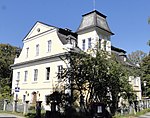
|
Ansitz, Mölk- or Reinhof ObjektID : 35569 |
Gärtnerstrasse 2 KG location : Salzburg |
The archiepiscopal valet Christoph Rein, who leased the Rainberg in 1680, had the Mölckhof built, which was initially called Reinhof, later also Hafnerhof. Felix Anton von Mölk, Prince Archbishop's Court Chancellor from 1752 to 1774, was another owner of the palace. The 17th century country estate was rebuilt in 1886 and is now equipped with a neo-baroque facade. |
ObjectID : 35569 Status : Notification Status of the BDA list: 2020-02-29 Name: Ansitz, Mölk- or Reinhof GstNr .: 3000/2 Gärtnerstraße 2, Salzburg |

|
Bürgerhaus, Schidenhofenhaus ObjectID : 35571 |
Getreidegasse 1 KG location : Salzburg |
The house is first mentioned in a document from 1363 on the occasion of a house sale. In 1855, a gable roof was built in place of the ditch roof, thus creating a new storey. The current appearance comes from the renovation in 1989. In the eventful history of the house, a. a gingerbread shop and wax drawing shop, an exchange office, a men's fashion store and the pension fund for the civil servants of the kk priv. Länderbank Wien . In 2003, Bank Austria Creditanstalt moved its branch into the house. |
ObjectID : 35571 Status : Notification Status of the BDA list: 2020-02-29 Name: Bürgerhaus, Schidenhofenhaus GstNr .: 342 |

|
Residential and commercial building, Ranftlhaus ObjektID : 35572 |
Getreidegasse 2 KG location : Salzburg |
The building, which originally consisted of two parts, was first mentioned in a document in 1370. There was probably a gatehouse with an apartment for the goalkeeper here. Parts of the city fortifications from 1280 are integrated into the house. The feudal character of the house comes from the baroque period. The toy store JB Neumüller existed here for over 100 years , which was then closed in 2009. The hat shop Scherzer , which has existed since 1920, still exists today. In 1997 the house was extensively renovated. |
ObjectID : 35572 Status : Notification Status of the BDA list: 2020-02-29 Name: Residential and commercial building, Ranftlhaus GstNr .: 507 |

|
Residential and commercial building, Schatz-Durchhaus ObjektID : 35573 |
Getreidegasse 3 KG location : Salzburg |
The house belonged to the castle law of St. Peter. Originally a city tower stood here. In 1363 the owner was Peter the old Keuzl. From 1547 Hanns Ritzinger became the house owner (also mayor). Arcades around 1540 and 1570; The builders were Hanns Rauchperger and Virgil Rauchperger. They had to leave Salzburg because of their Protestant faith. From 1660 owned by the Mayr family (Faktor Mayr-Haus). 1827 owned by Alois Duregger, from whom it came to Drechsler Schatz in 1859. |
ObjektID : 35573 Status : Notification Status of the BDA list: 2020-02-29 Name: Residential and commercial building, Schatz-Durchhaus GstNr .: 343/1; 343/2 Schatz-Durchhaus, Salzburg |
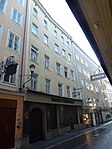
|
Community center , pharmacy, Zum Goldenen Biber ObjektID : 35574 |
Getreidegasse 4 KG location : Salzburg |
This building developed from two houses, one of which was facing the Getreidegasse , the other facing the Salzach . In 1608 the pharmacist Johann Wiser opened the pharmacy shop and medicine shop in Traegasse . In 1900 the pharmacy was renovated in the Art Nouveau style. In 1990, during restoration work, high-quality wall paintings with exotic plants were discovered, which were probably created in 1760. |
ObjectID : 35574 Status : Notification Status of the BDA list: 2020-02-29 Name: Bürgerhaus, pharmacy, Zum Goldenen Biber GstNr .: 500; 503 Getreidegasse 4, Salzburg |

|
Bürgerhaus, Zezi-Kaufmannhaus ObjectID : 35575 |
Getreidegasse 5 KG location : Salzburg |
According to a chronicle, the house was built around 1200. However, it is mentioned in a document in 1434 as the property of Anna Wagenschlaffin. In 1764 Josef Anton Zezi acquired the Jennersche specialty and material goods store , which later became the Anton Zezi drugstore . This business was maintained until 1984, but then had to give way to a restaurant in the textile industry. |
ObjectID : 35575 Status : Notification Status of the BDA list: 2020-02-29 Name: Bürgerhaus, Zezi-Kaufmannhaus GstNr .: 344 |
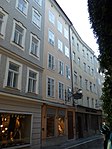
|
Residential and commercial building, Gritzenbergerhaus ObjectID : 35576 |
Getreidegasse 6 KG location : Salzburg |
The house is mentioned as a typical Salzburg town house with three window axes as early as 1334, when the Aychaim brothers sold the house to Martin Speher. In the 17th century the house is "stuck", i. H. sold as condominium. In 1865 the house was rebuilt by the furrier Franz Zimmermann. The Springer brothers followed as the successors to the furrier family in 1916, and their fur business lasted until the 1990s. |
ObjectID : 35576 Status : Notification Status of the BDA list: 2020-02-29 Name: Residential and commercial building, Gritzenbergerhaus GstNr .: 499 |
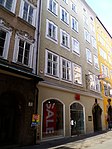
|
Residential and commercial building, Reifenstuhlhaus ObjektID : 35577 |
Getreidegasse 7 KG location : Salzburg |
The house belonged to the castle law of St. Peter. It has a spacious arcaded courtyard. The first owner mentioned was Peter Freitag (Mayor of Salzburg 1411-1416). Arcades from 1546 or before 1574; Builders Jörg and Ruprecht Payr. In the 17th century there was partly an inn here. In the 19th century the iron merchant Michael Roittner and his wife Hedwig are named as house owners. It has been renovated since 1979 and is a good example of the Renaissance culture of Salzburg patricians. From 1819 to 1976 the iron wholesaler Gebr. Roittner was located here . In 2009 the textile company H&M moved in here as the successor to Thalhammer. |
ObjectID : 35577 Status : Notification Status of the BDA list: 2020-02-29 Name: Residential and commercial building, Reifenstuhlhaus GstNr .: 345 |
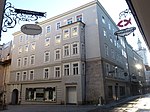
|
Bürgerhaus, Mühlsteigerhaus, Ramsauerhaus ObjectID : 35578 |
Getreidegasse 8 KG location : Salzburg |
This house was acquired in 1334 by Martin Speher from the brothers Friedrich and Gottlieb Aychaim. The bay window on Hagenauerplatz that extends up to the third floor is remarkable. In the 17th century the house was "stuck up" and a large number of partial owners lived here. Around 1784 the reading room of the reading society was housed here. From 1816 onwards, the Gasthof Zur golden Krone , which was run as a hotel from 1918, was housed here. In 1896 the facade was changed by Jacob Ceconi . From 1918 the traditional Roittner company (tableware and household goods) moved in here. This existed until 1998, now a fashion store and a shoe boutique are housed here. |
ObjectID : 35578 Status : Notification Status of the BDA list: 2020-02-29 Name: Bürgerhaus, Mühlsteigerhaus, Ramsauerhaus GstNr .: 498 |
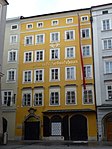
|
Bürgerhaus, Mozart's birthplace ObjectID : 35579 |
Getreidegasse 9 KG location : Salzburg |
The castle right house of St. Peter is first mentioned in 1408 in the possession of Ottel Keuzl (mayor 1414-1415). Arcades from the beginning of 1540 and the beginning of the 17th century, built by Virgil Rauhenperger and his wife Benigna Pachhaimer and Michael Widmer. In 1712 the house came into the hands of the grocer and city councilor Josef Martin Hagenauer. The house and trading license went to Johann Lorenz Hagenauer in 1736, who rented the third floor of the house to Leopold Mozart from 1747 to 1773 . In 1897 the grocer Stranz & Scio bought the house; the business no longer exists today. Today no longer usable as a passage house. |
ObjectID : 35579 Status : Notification Status of the BDA list: 2020-02-29 Name: Bürgerhaus, Mozart's birthplace GstNr .: 346 Mozart's birthplace |

|
Bürgerhaus, Gollhoferhaus, Sailerwirt ObjectID : 35580 |
Getreidegasse 10 KG location : Salzburg |
For the first time in 1424 a Chunrad child from a ministerial family is mentioned as the owner. Arcade courtyard, western section, was built in 1560 and the eastern section at the end of the 16th century, builders were Sebastian Althamer and Andrä Althamer. Around 1600 the archbishop's house was called a dwelling , probably because the archbishop's officials were housed here. In 1626 Franz Johann Sailer set up an inn. From 1727 the house was called Zum Goldenen Einhorn , 1772 under J. Adam Oechsler Oexlerisches Weinwirtshaus , 1830 under J. Nelböck Gasthof Zu den Drei Allied , in 1865 the concession was transferred to the newly built Grand Hotel de l'Europe by Alois Ludwig Jung . Then division of the house: the part in Getreidegasse was bought by the merchant Karl Schattenfroh, who in Griesgasse was bought by Anton Daghofer. Various renovations in the 20th century, through which some valuable fittings were made visible again. |
ObjectID : 35580 Status : Notification Status of the BDA list: 2020-02-29 Name: Bürgerhaus, Gollhoferhaus, Sailerwirt GstNr .: 493 |

|
Mansion, barriers Bäckerhaus Object ID: 41530 |
Getreidegasse 11 KG location : Salzburg |
The castle right house of St. Peter belonged to the Lords of Lampoting in 1380. The arcade courtyard was built in 1560, the builders were the heirs of Amandus Gützner (mayor and city council). From 1858 the front and rear buildings were separated in the land registry. There have been several bakeries here since the 19th century, such as the Feichtner family's Viennese bakery from 1912 , which had to close at the turn of the millennium due to exhaust air pollution from the bakery . In the former bakery there is now a branch of the Nordsee chain . |
ObjectID : 41530 Status : Notification Status of the BDA list: 2020-02-29 Name: Bürgerhaus, Schrankenbäckerhaus GstNr .: 347 |
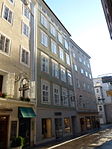
|
Residential and commercial building, Kammerlohrhaus ObjektID : 35581 |
Getreidegasse 12 KG location : Salzburg |
Mentioned in 1424 is the sale of the house by the bourgeoisie Heinrich and Dorothee Dienstl to Heinrich Klanner (Salzburg mayor from 1465). Arcade courtyard with Tuscan columns made of dark Adnet marble originated at the end of the 16th century, the builders were Niclas Plazer and his wife Elisabeth Geizkofler. In 1678, Franz Volpert von Kammerlohr bought the house, although this family was reported as part of the owner until the turn of the 19th century. Around 1880 the house was split up into eight property parts. In 1873 the Hackenbuchner paper goods company (printer, paper wholesaler, office supplies) moved in here. In 2006 a large part of the house was leased to a German fashion chain; a small shop of the office supply company Hackenbuchner is now in the house at Getreidegasse 14 . |
ObjectID : 35581 Status : Notification Status of the BDA list: 2020-02-29 Name: Residential and commercial building, Kammerlohrhaus GstNr .: 492/1 |
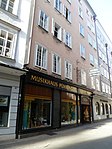
|
Residential and commercial building, holiday house ObjectID : 35582 |
Getreidegasse 13 KG : Salzburg |
In 1425 a Hans Vitl is mentioned as the first owner. From 1744 the house was "stuck". In 1907 the former attic was converted into a fourth residential floor. A comprehensive renovation took place in 1976/77. In the last decades of the 19th century the hardware store Lauzenz Ibetsperper & Comp. The Pühringer music house has been located here since 1926 . |
ObjectID : 35582 Status : Notification Status of the BDA list: 2020-02-29 Name: Residential and commercial building, holiday house GstNr .: 349 Getreidegasse 13, Salzburg |

|
Residential and commercial building, Kronhaus ObjektID : 35583 |
Getreidegasse 14 KG location : Salzburg |
After it was first mentioned in 1438, the house was owned by Hanns Praun. In its older parts of the current stock, the house dates from the 16th century. A restaurant is mentioned for the first time in 1647 ( Golden-Kronhaus ). In 1811 the royal Bavarian foundation administration established a poor house ( Kronhaus ) in the rear building . From 1910, the Franz Moltner sports and textile goods store was located here , which was closed in 1990. A souvenir shop opened under the same name since 2008. |
ObjectID : 35583 Status : Notification Status of the BDA list: 2020-02-29 Name: Residential and commercial building, Kronhaus GstNr .: 484/2 |

|
Residential and commercial building, Azwangerhaus ObjektID : 35584 |
Getreidegasse 15 KG location : Salzburg |
The first known owner is Peter Setzfues, who is mentioned in 1412. From 1510 it belongs to Hans Thenn, high princely mint master. Arkadenhof was built in 1560 and 1600, builders were Hans Thenn (II.) And Rosina Alt, née Thenn, married to Tobias Alt, or their heirs. In the 18th and 19th centuries the house belonged to the Azwanger family. In addition to the Azwanger delicatessen shop , there was also a doll clinic and the Fanny Schwendmayr clothing store. Until the turn of the millennium, the Resmann women's fashion store was also here . Remodeling in 1974. |
ObjektID : 35584 Status : Notification Status of the BDA list: 2020-02-29 Name: Residential and commercial building, Azwangerhaus GstNr .: 350 Getreidegasse 15, Salzburg |
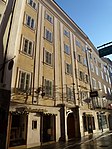
|
Bürgerhaus, Gschwendtnerhaus / Haus an der Alben ObjectID : 41399 |
Getreidegasse 16 KG location : Salzburg |
The first owners are documented as early as the 14th century; in 1330 it belonged to the furrier Niclas and in 1360 to Dietrich, Lord of Salzburg Chürsner . A skinning could be created here because the Almkanal flowed here. Bankhaus Berger & Co had the building renovated in 1960, and in 1988 it was extensively renovated. Now there is a branch of the perfumery chain Marionnaud here . |
ObjectID : 41399 Status : Notification Status of the BDA list: 2020-02-29 Name: Bürgerhaus, Gschwendtnerhaus / Haus an der Alben GstNr .: 482 |

|
Residential and commercial building, Rabelbäckerhaus ObjektID : 35585 |
Getreidegasse 17 KG location : Salzburg |
The house belonged to the castle law of St. Peter. The house originally belonged to the baker Leopold. In 1360 it was sold by Heinrich von Zell to Margareth Fuettersacher. Partly wooden arcades in the inner courtyard. Classicist facade design towards the end of the 18th century. In 1892 the master baker Friedrich Jentsch is mentioned, whose name was to be seen with the addition of bakery until 1978. The basement was designed in 1979 with arched shop windows. Until 1998 the fashion house FX offering kuch was housed here, today it is a branch of a traditional costume company. |
ObjectID : 35585 Status : Notification Status of the BDA list: 2020-02-29 Name: Residential and commercial building, Rabelbäckerhaus GstNr .: 351 |

|
Residential and commercial building ObjectID : 35586 |
Getreidegasse 19 KG location : Salzburg |
In 1385 the judge and mayor Martin Aufner is mentioned as the owner of the house peim Frongarten auff der alben ; this house was built over part of the Alm Canal . In 1603 the house was acquired by Archbishop Wolf Dietrich von Raitenau , who in 1605 had the princely mint moved there. In the 1930s, the Tagwerker company moved in, which then had to give way to an Italian fashion chain at the turn of the millennium. |
ObjectID : 35586 Status : Notification Status of the BDA list: 2020-02-29 Name: Residential and commercial building GstNr .: 353 |

|
Gasthaus, Zum Wilden Mann, Sattlerstöckl ObjectID : 42260 |
Getreidegasse 20 KG location : Salzburg |
The house consists of three to 1500 separate objects with different landowners (St. Peter, Bürgerspital, Stadt). In 1509 the city bought the front objects from Lorenz Pagner and placed the iron defeat there, which was previously on the Brodmarkt. In addition, the city built a rear building on Gries around 1619. Two-story arcades from the 17th century are located in the inner courtyard. From 1805 the city sold the buildings in storeys. The former Sattlerstock was owned by Anton Nowak in 1884, who moved the Zum Wilden Mann inn from Griesgasse here. |
ObjectID : 42260 Status : Notification Status of the BDA list: 2020-02-29 Name: Gasthaus, Zum Wilden Mann, Sattlerstöckl GstNr .: 479 Gasthaus Wilder Mann (Salzburg) |
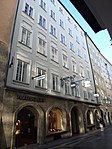
|
Bürgerhaus, Kaltenbrunnerhaus, Fabrizenhaus ObjectID : 35587 |
Getreidegasse 21 KG location : Salzburg |
The right house of the castle of St. Peter Abbey was owned by Hübschen (Hübschmann) in 1387. In 1392 Christian Pachmayr's wife and heirs were granted permission “to build on the Frongarten wall, as long as their house and court deeds show in the Tragassen”. Arcade courtyard with columns made of Adnet marble originated at the end of the 1560s; the builders were Gervasius Fabricius and his wife Allolonia Rauchberger. Wall fountain from 1610 on the first floor. In 1744 the house was divided into condominiums. The house has a classical facade. In 1972 a passage to the university square was created. In 1987 a facade renovation was carried out. |
ObjectID : 35587 Status : Notification Status of the BDA list: 2020-02-29 Name: Bürgerhaus, Kaltenbrunnerhaus, Fabrizenhaus GstNr .: 354; 355 Kaltenbrunnerhaus, Getreidegasse 21, Salzburg |

|
Residential and commercial building, Niederleghaus ObjectID : 35588 |
Getreidegasse 22 KG location : Salzburg |
A land register of the St. Peter calls 1230-1238 here the miller Maquart; it was a mill house here that was run by the Almkanal. The mill also had a bakery, which was owned by Niclo von Auczse in 1330. This also included a residential tower with a crenellated wreath on the first city wall, which was restored in 1930. The two buildings on the Getreidegasse side merged into one building in 1480. In 1508/09 an urban defeat was built here, in which merchants could keep their goods. This right of deposit or stacking was exercised by the city until 1828. Then the city sold the stock piece by piece. Café Mozart was established here in 1922 . |
ObjectID : 35588 Status : Notification Status of the BDA list: 2020-02-29 Name: Residential and commercial building, Niederleghaus GstNr .: 481 Getreidegasse 22, Salzburg |
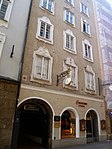
|
Residential and commercial building ObjectID : 35589 |
Getreidegasse 23 KG location : Salzburg |
In 1387 the house was first mentioned by the owner Ruep (Ruprecht) Zandl (Mayor of Salzburg 1411). He was allowed to build on the front garden and break out windows. This is followed by the merchant Virgil Venediger. Arkadenhof was built between 1550 and 1570, the builders were two members of the influential Matsperger family (Sebastian Matsberger was a city councilor). In 1744 the house was divided into condominiums. Around 1800 classicistic facade design, with the side facing Getreidegasse being redone in 1926 in a historicizing way. In 1873 the Tomasellis are also listed as owners. Extensive renovation work between 1972 and 1980. Now there is a jewelry passage here . |
ObjectID : 35589 Status : Notification Status of the BDA list: 2020-02-29 Name: Residential and commercial building GstNr .: 356 |

|
Reutterhaus, Lambergerhof and part of the city wall ObjectID : 35590 |
Getreidegasse 24 KG location : Salzburg |
The first known owner is Martin Reutter (caretaker of Radeck and Glaegg and city judge) in 1414. The house came to Caspar von Lamberg through marriage (1528). Archbishop Paris Lodron bought the building in 1647 and had the Collegium Marianum housed in it. In 1914, Ludwig Ornstein opened his clothing store there. After the “ Aryanization ” in 1938, the clothing store was taken over by Kurt Thalhammer. After it was returned to the Ornstein family, the house was sold to the Mühlberger clothing store in 1962. Radical renovation in 1964. In 1988, the state before 1964 was restored. Now there is a Spanish clothing company here. |
ObjectID : 35590 Status : Notification Status of the BDA list: 2020-02-29 Name: Reutterhaus, Lambergerhof and part of the city wall GstNr .: 475; 476/1 |

|
Walls, part of the 2nd city wall ObjectID : 42706 |
at Getreidegasse 24a KG location : Salzburg |
ObjectID : 42706 Status : Notification Status of the BDA list: 2020-02-29 Name: Walls, part of the 2nd city wall GstNr .: 476/2 |
|

|
Bürgerhaus, Nussdorfer- or Schwabenhaus ObjektID : 35591 |
Getreidegasse 25 KG location : Salzburg |
The house, which is subject to the castle rights of St. Peter, belonged to the Nussdorfern family in 1372, a noble ministerial family. In 1533 the house was replaced by David Nussdorfer from the manor. Arcade courtyard (partly wooden pillars) created in 1560, the builders were Hans Strobl in the Nussdorf house and from 1630 Hans Lorenz Schwab. From 1713 the house belonged to the University of Salzburg and until 1810 to the university fund. In 1835 the house was auctioned and came into the possession of District Administrator Franz Schraml. Later it came to the Kindlinger family, who set up a textile shop here. 1938 “ Aryanization ” of the partial ownership of Rudolf and Karl Askona; Restitution after 1945. The house got its current appearance through renovation work between 1968 and 1981. Today it houses a shoe and fashion shop. |
ObjectID : 35591 Status : Notification Status of the BDA list: 2020-02-29 Name: Bürgerhaus, Nußdorfer- or Schwabenhaus GstNr .: 357/1 |

|
Gasthaus, Mödlhammerhaus / to the golden lion ObjectID : 41400 |
Getreidegasse 26 KG location : Salzburg |
Already in 1414 the house belonged to the brewer Niclas; from 1429 a brewery is listed. From 1631 there was an inn Zum Goldenen Löwen (from 1697 Metlhamer- or Mödlhammerbräu ). The brewery was closed in 1874. At the beginning of the 20th century, a prayer room was rented in the house for the Jewish community. In 1932 the house was completely renovated by Franz Niedermayer and Thomas Felber. In 1946 the dance-cabaret Varieté Oase moved in , and in 1947 a cabaret was housed in the house. A McDonalds branch has been located here since 1982 . |
ObjektID : 41400 Status : Notification Status of the BDA list: 2020-02-29 Name: Gasthaus, Mödlhammerhaus / zum golden Löwen GstNr .: 474/3 Getreidegasse 26, Salzburg |

|
Bürgerhaus, Baron Lassberg House ObjectID : 41535 |
Getreidegasse 27 KG location : Salzburg |
In 1387 Georg der Aygerl, a citizen and trader with Venice, received permission to lay the wall to the Frongarten across the width of the house and to build a house with built-in bars on the windows. Arkadenhof was built between 1540 and 1660; the builders were Johann and Wolf Oeder. In 1911 Adam Mittermayer opened a bakery here, which existed until 1977. In 1980 the fish restaurant chain Nordsee moved here. There has also been a café in the house since 1870, but the name and owner often changed (Express-Café Figaro, Café Kommar, now Café Getreidegasse). |
ObjectID : 41535 Status : Notification Status of the BDA list: 2020-02-29 Name: Bürgerhaus, Baron Lassberg-Haus GstNr .: 358 |

|
Bürgerhaus, Sailerstöckl ObjectID : 42707 |
Getreidegasse 28 KG location : Salzburg |
The first owner is the blacksmith Ottl, mentioned in 1389. In 1414 a brewery was set up here. In 1830 there were four house owners and the house was divided into different owners; the rear annex became number 28. In the 19th century, this was first a carriage business, then several metalworking shops. After the Second World War, Herbert Forsthuber's delicatessen shop was here; today, the Wieber locksmith's and locksmith's shop is located in the house. |
ObjectID : 42707 Status : Notification Status of the BDA list: 2020-02-29 Name: Bürgerhaus, Sailerstöckl GstNr .: 471; 474/2 |
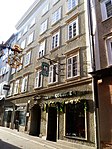
|
Bürgerhaus, Sternbäckerhaus ObjektID : 41529 |
Getreidegasse 29 KG location : Salzburg |
The house dates from the 13th century; the first owner was Ortlein von Salzburghofen, who enlarged the house towards the Frongarten. A baker (Christoph Pfenninger) is mentioned for the first time in 1569, although the bakery existed until 1930. Instead of the bakery, Albert and Agnes Kaltenegger set up a cleaning shop, after which the Bayer confectionery shop was located here . Now knitwear, shoes and traditional costumes are sold in the house. The year 1730 above the baroque portal suggests a major renovation. |
ObjectID : 41529 Status : Notification Status of the BDA list: 2020-02-29 Name: Bürgerhaus, Sternbäckerhaus GstNr .: 359 |

|
Bürgerhaus, Schafmannhaus ObjectID : 35592 |
Getreidegasse 30 KG location : Salzburg |
This house emerged from house number 28 , which was divided between four homeowners in 1830. In 1839 the owners were Walburga Mösner, Andreas Mayer and the shoemaker Johann Oberörg. Major modifications were made in 1857. In 1909 the instrument makers Josef and Karl Wessely lived here and ran a shop here. In 1950 an optician moved into the sales rooms and now there is a children's fashion store here. |
ObjectID : 35592 Status : Notification Status of the BDA list: 2020-02-29 Name: Bürgerhaus, Schafmannhaus GstNr .: 472 |

|
Hotel Goldenes Horn, Zur Grünen Linde ObjectID : 35593 |
Getreidegasse 31 KG location : Salzburg |
This house was always an inn and from the 19th century a hotel. In 1434 members of the Schürger family are mentioned as the first owners. From 1568 a host is here meet same run (Michael Koch Berger), the 1633 linden to grien (after a Besitzerzwechsel later Horner pub ) and in 1826 the Golden Horn said. In 1911 the house was completely renovated. The house was damaged by a bomb attack on April 25, 1945. A through-house was created during the renovation in 1966. The hotel was closed in 1980 and is now a fashion house. |
ObjectID : 35593 Status : Notification Status of the BDA list: 2020-02-29 Name: Hotel Goldenes Horn GstNr .: 360 |
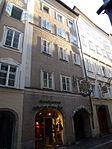
|
Residential and commercial building, Tuchschererhaus ObjektID : 35594 |
Getreidegasse 32 KG location : Salzburg |
The first owner was a Stefan Schwablein, mentioned in 1406. A Beutler also worked in the house in the 15th century , a trade that was widespread at the time. A glazier moved here around 1800, and this trade lasted until the end of the 20th century. In the 1930s, Philipp Gronich opened a shop for hats and fur goods here, and today the Aschauer company is a hat specialist here. |
ObjectID : 35594 Status : Notification Status of the BDA list: 2020-02-29 Name: Residential and commercial building, Tuchschererhaus GstNr .: 473 |
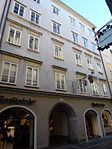
|
Bürgerhaus, Reitterhaus ObjectID : 35595 |
Getreidegasse 33 KG location : Salzburg |
The house belonged to the Pranckhern , Ministeriale in Salzburg and knights with fiefdoms in Styria even before 1434 . Sold on October 1, 1641 to the High Princely Councilor Corbinian Niedermayr. Arkadenhof originated in the 1st half of the 17th century, builders were Barbara Gei (t) zkofler or Corbinian Niedermayr. Around 1800 classicistic design of the facade. The Stockhamerbräu was operated here around 1648. The brewery was given up in 1865 and the Zum Stockhamer inn was established, which lasted into the 20th century. The house was damaged in the bombing raid on April 25, 1945. Albert Brändle's wicker shop moved in here before a clothing store opened its sales rooms. |
ObjectID : 35595 Status : Notification Status of the BDA list: 2020-02-29 Name: Bürgerhaus, Reitterhaus GstNr .: 361 Getreidegasse 33, Salzburg |
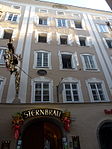
|
Gasthaus, Sternbräu with arcade courtyard and Sternstöckl ObjektID : 41528 |
Getreidegasse 34-36 KG location : Salzburg |
The building originally dates back to three houses, one of which was located on the second city wall (Stöckl) and is only later counted as a separate house. The first owner is Hofsmid Hartel in 1408 . This forging tradition continued into the 16th or 17th century ( court smithy on Getreidegasse until 1656). From 1636 Philipp Tunzler owned the Würth house near the gulden star . In 1743 Matthias Wilhelmseder built a richly furnished baroque chapel on the first floor of the house. After the brewery was relocated to Riedenburg in 1907, the passage to Griesgasse was created in 1909. In 1929 the Sternbräu was acquired by Österreichische Brau AG and again extensively renovated. The Sternbräu was badly damaged on April 24, 1945. |
ObjectID : 41528 Status : Notification Status of the BDA list: 2020-02-29 Name: Gasthaus, Sternbräu with Arkadenhof and Sternstöckl GstNr .: 464 |
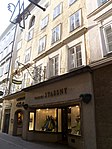
|
Town house, former Stockhamer house ObjectID : 35596 |
Getreidegasse 35 KG location : Salzburg |
The first owner (mentioned in 1407) of this late Gothic house is Peter Hafftler. As early as 1536, the brewer Martin Steuber is mentioned in the house. In 1569 it was first referred to as the brewery. Under Erich Stockhamer, the Stockhamerbräu became the third largest brewery in Salzburg in 1680. The brewery was not given up until 1865. From 1898 to 1937, Johann Ensmann worked here as a strap maker, as well as a confectioner and Gratian Wacht's dye works and clothes cleaning department. On April 25, 1945, the house was damaged by a bomb attack. In 1973 it went to the Golden Deer , which was able to double its capacity. |
ObjectID : 35596 Status : Notification Status of the BDA list: 2020-02-29 Name: Bürgerhaus, former Stockhamer house, GstNr .: 362 Getreidegasse 35, Salzburg |

|
Hotel Goldener Hirsch ObjectID : 35597 |
Getreidegasse 37 KG location : Salzburg |
The first owner is Heinrich des Hulczein Weber in 1407 . The pub zum Güldenen Hürschen (later also called Hirschlwirt ) was mentioned for the first time in 1671 under Paul Gschwandtner . In 1939 the house came into the possession of Emanuel and Harriet Walderdorff. In 1947 the house was extensively renovated. In 1970 the Goldene Hirsch was acquired by Carl Adolf Vogel , who also bought the adjacent Stockhamerbräu and added it to the hotel. Since 1976 the business has been taken over by various international hotel consortia. |
ObjectID : 35597 Status : Notification Status of the BDA list: 2020-02-29 Name: Hotel Goldener Hirsch GstNr .: 363 Hotel Goldener Hirsch (Salzburg) |

|
Bürgerhaus, Kaspis, Altes Sternhaus ObjectID : 35598 |
Getreidegasse 38 KG location : Salzburg |
In the Urbar of the Civil Hospital which is 1321 here Mertel dwelling mentioned. In 1401 it belonged to a Lisst, from 1416 to Simon Ennser. Around 1800 the house was sold because of a dilapidation process. In 1848 the house went to Barbara Daghofer. Leopold Bachmayer had his general store here, who also bought the house. After 1950 a Josef Koberger ran a typewriter and sewing machine shop here; a hairdresser was also housed here. Now the branch of a linen shop is rented here. |
ObjectID : 35598 Status : Notification Status of the BDA list: 2020-02-29 Name: Bürgerhaus, Kaspis, Altes Sternhaus GstNr .: 463 |

|
Residential and commercial building, Kollegimesnerhaus, Schinaglhaus ObjektID : 35599 |
Getreidegasse 39 KG location : Salzburg |
The house is only six meters wide and has been home to the Sporer liquor and wine store for over 100 years. The property was first mentioned in 1407 as the property of the Kundl blacksmith. Over the centuries, the house housed many trades (carpenters, furriers, bricklayers). After 1742 home ownership begins to be broken up with three or four owners. In 1905, Franz Sporer from Innviertel bought part of the building and opened a brandy, liqueur, etc. Rum business (in wholesale detail) . This house was damaged on April 25, 1945. In 1987 a comprehensive renovation took place. |
ObjectID : 35599 Status : Notification Status of the BDA list: 2020-02-29 Name: Residential and commercial building, Kollegimesnerhaus GstNr .: 364 |
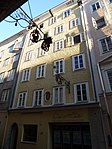
|
Bürgerhaus, Haselbäckerhaus ObjektID : 41534 |
Getreidegasse 40 KG location : Salzburg |
1402 it is designated as the house of Newpekchen . From 1597 ( Stachlsbäckerhaus ) bakeries were located here continuously until the 20th century. It was then that the division and stuccoing of the house began. The bakery tradition ended in 1958 with the Bach bakery, which was replaced by the ice grotto (only open in the warm season) and a chocolate shop (during the winter months). |
ObjectID : 41534 Status : Notification Status of the BDA list: 2020-02-29 Name: Bürgerhaus, Haselbäckerhaus GstNr .: 462 |

|
Gasthaus, Zur Blauen Gans , Täublhaus ObjectID : 35600 |
Getreidegasse 41-43 KG location : Salzburg |
In 1434 the Enns family owned house no. 40. In 1493 it passed to three owners. Among the homeowners were u. a. Lute maker (Michl Gartner, Christoph Helm), shoemaker, Mautner and court musician. A relationship with the Blauer Gans already existed around 1800 , as the owner of house no. 41 also wanted to convert the attic of no. 40 into a bulk floor. From 1919 it belonged to the Blue Goose . House no. 43 was owned by the Aufner in the middle of the 14th century, who then handed it over to the citizens' hospital. It has been called an inn since 1569. Under the tenant Bartlmä Rexeisen, the inn was first called zur plaben Gans . Through a marriage in 1717, the Blue Goose and the Golden Deer came into one hand, but the former was always managed by a tenant. The landlord Georg Gadermayer and his wife Walburga united the two houses. This house was damaged in the bombing on April 25, 1945. After 1945 the house was used as a troop accommodation for the military police. Between 1998 and 2002 there was a complete renovation and the reopening as the Arthotel Blaue Gans . |
ObjectID : 35600 Status : Notification Status of the BDA list: 2020-02-29 Name: Gasthaus, Zur Blauen Gans GstNr .: 365; 366 Hotel Blaue Gans, Salzburg |

|
Bürgerhaus, Fragnerhaus ObjectID : 67766 |
Getreidegasse 42 KG location : Salzburg |
House no. 42 is mentioned as early as 1402 and is owned by the Toman von Chessen. In 1700 the house was divided into several parts. In the 19th century, mainly grocery stores were housed here, but the pewter founder Spieker was also found here. After the warehouse of the Mödlinger shoe factory and the furniture dealer Schlecht , the Fritsch company followed , selling shoes and traditional costumes. |
ObjectID : 67766 Status : Notification Status of the BDA list: 2020-02-29 Name: Bürgerhaus, Fragnerhaus GstNr .: 461 |

|
Bürgerhaus, Wieserhaus ObjectID : 41533 |
Getreidegasse 44 KG location : Salzburg |
Toman von Chessen appears as the first owner in 1402. In 1733 the house was divided into "three floors". Around 1800 the shoemaker Egis Wieser, who employed between 12 and 15 journeymen, was housed here. Then the master weaver Josef Schwarzenberger moved in here. In 1930 the main business of the Fritsch brothers (leather goods) moved here. This house was damaged in the bombing on April 25, 1945. In 1955 the Fritsch brothers carried out extensive renovations. Today there is a boutique here. |
ObjectID : 41533 Status : Notification Status of the BDA list: 2020-02-29 Name: Bürgerhaus, Wieserhaus GstNr .: 460 |

|
Bürgerhaus, Färberhaus ObjectID : 35601 |
Getreidegasse 45 KG location : Salzburg |
In 1455 a Hanns Winterseer, a dyer from Thurgau, is mentioned as a house owner. The dyer fair was exercised until the middle of the 19th century. The house was stuck in 1680 and later in 1739. The traditional business Feinkost Ruppe Co., founded in 1859 , was only closed in 1990. Today there is a jewelry store and the sales office of a French leather goods company. |
ObjectID : 35601 Status : Notification Status of the BDA list: 2020-02-29 Name: Bürgerhaus, Färberhaus GstNr .: 367 |
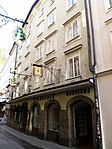
|
Town house, coppersmith house, Lebzelter-Thaller-Haus ObjectID : 35602 |
Getreidegasse 46 KG location : Salzburg |
This corner house on Sterngässchen has grown together from three houses. The right of the two houses on the Getreidegasse side belonged to Hanns Trenkchschalb in 1402 . In 1581 this house was so dilapidated that it had to be completely renovated. The house on the left on the egk in Gaßl was owned by the landlady in 1402 . In 1512 the house is called Kaplan- or Ausreiterhaus , whereby an Ausreiter is a chaplain who had to take care of pastoral care outside the city and had a horse available for it. The two houses were structurally united around 1600. In 1963 the building police released the building for demolition, but it was saved by the Federal Monuments Office by placing it under protection. Today there is a shoe shop, a perfumery and a jeweler in the house. |
ObjectID : 35602 Status : Notification Status of the BDA list: 2020-02-29 Name: Bürgerhaus GstNr .: 459 |
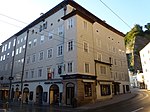
|
Residential and commercial building, former Wagnerhaus, Spitalschmiedhaus ObjectID : 35603 |
Getreidegasse 47 KG location : Salzburg |
This house was built from several parts. In 1322, the owner at the time, Andrä Pondorffer, sold half a house to the shoemaker Berthold, including the courtyard in Trágassen pey dem admundtsprunnen . The other unit was the coppersmith's house that existed in 1470 . Virgil Oeder received the approval to build a one-story extension to his house in the direction of Frongarten, from which a three-story rear building was built over time. A vault was built over the free-standing fountain, from which the bay window was created. Blacksmiths and Wagner worked here until the 1920s. In 1928 the product dealer and shopkeeper Georg Wimmer succeeded him in ownership . This house was damaged by the April 25, 1945 bombing. In 2004 the house was rebuilt and completely renovated. |
ObjektID : 35603 Status : Notification Status of the BDA list: 2020-02-29 Name: Residential and commercial building, Former Wagnerhaus GstNr .: 368 Getreidegasse 47, Salzburg |
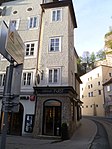
|
Residential building ObjektID : 89445 |
Getreidegasse 49 KG location : Salzburg |
ObjectID : 89445 Status: § 2a Status of the BDA list: 2020-02-29 Name: Residential house GstNr .: 387 |
|

|
Bürgerhaus, Wechsler- oder Lasserhaus ObjectID : 35663 |
Giselakai 1 location KG: Salzburg |
ObjectID : 35663 Status : Notification Status of the BDA list: 2020-02-29 Name: Bürgerhaus, Wechsler- or Lasserhaus GstNr .: 509 |
|
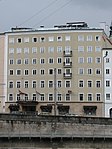
|
Bürgerhaus, Hotel Stein ObjectID : 46790 |
Giselakai 3-5 KG location : Salzburg |
The house "Am Stain" ("Stainbräu") was first mentioned in 1399 under its owner Matthias Zwickl. 1528 appears as the brewer Hans Gapler. At that time, the house consisted of two adjacent inns, with Mathias and Ernst (Lederer) serving as hosts in the outbuilding since 1526. In 1654 it was then called "Martin Wirfl Host Zum Gulden Widder". In 1664 both houses were united under the brewer Franz Dietrich Popp. The brewery closed in the 1880s. The last Steinbräu was Josef Griesberger. Alois Grasmayr acquired the Hotel Stein in 1914 . |
ObjectID : 46790 Status : Notification Status of the BDA list: 2020-02-29 Name: Bürgerhaus, Hotel Stein GstNr .: 510; 511 |

|
Bürgerhaus, Wimmerhaus ObjectID : 46793 |
Giselakai 7 KG location : Salzburg |
ObjectID : 46793 Status : Notification Status of the BDA list: 2020-02-29 Name: Bürgerhaus, Wimmerhaus GstNr .: 512 |
|

|
Bürgerhaus ObjektID : 46794 |
Giselakai 9 KG location : Salzburg |
ObjectID : 46794 Status : Notification Status of the BDA list: 2020-02-29 Name: Bürgerhaus GstNr .: 514 |
|

|
Bürgerhaus, Englwirtshaus ObjectID : 43139 |
Giselakai 11 KG location : Salzburg |
The structure of the five-storey town house dates from the 15th and 16th centuries. The facades of the upper floors were redesigned at the end of the 19th century. |
ObjectID : 43139 Status : Notification Status of the BDA list: 2020-02-29 Name: Bürgerhaus, Englwirtshaus GstNr .: 515 |
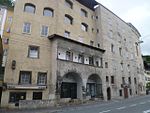
|
Bürgerhaus, Sleytzerhaus ObjectID : 46804 |
Giselakai 15 KG location : Salzburg |
The house is mentioned in 1428 as "Hofstatt an der Brück". Jews lived here in 1429, and a Jacob Jud owned the house from 1477 to 1512. Then it will be made available to the town clerk Zehen (t) perger. Then Gürtler Füller (Fuller) acquires it; his son was mayor of Salzburg for some time. In 1709 the master dyer Tobias Riegersperger appears here. Before the turn of the 19th century, the master painter Jacob Forstner ran his craft here. He was succeeded by Johann Fürst (Imperial and Royal Court Decorator). |
ObjectID : 46804 Status : Notification Status of the BDA list: 2020-02-29 Name: Bürgerhaus, Sleytzerhaus GstNr .: 520 Giselakai 15, Salzburg |
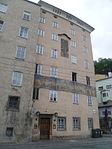
|
Gasthaus ObjektID : 38572 |
Giselakai 17 KG location : Salzburg |
The core of the six-storey house dates from the 15th century. |
ObjectID : 38572 Status : Notification Status of the BDA list: 2020-02-29 Name: Gasthaus GstNr .: 521 |

|
Villa / Country House ObjectID : 47996 |
Giselakai 29 KG location : Salzburg |
ObjectID : 47996 Status : Notification Status of the BDA list: 2020-02-29 Name: Villa / Landhaus GstNr .: 553 |
|
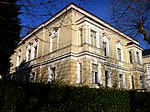
|
Torkosvilla ObjectID : 48070 |
Giselakai 35 KG location : Salzburg |
ObjectID : 48070 Status : Notification Status of the BDA list: 2020-02-29 Name: Torkosvilla GstNr .: 560 |
|

|
Villa / Country House ObjectID : 46785 |
Giselakai 39 KG location : Salzburg |
ObjectID : 46785 Status : Notification Status of the BDA list: 2020-02-29 Name: Villa / Landhaus GstNr .: 563 |
|

|
Czernyvilla ObjectID : 47993 |
Giselakai 45 KG location : Salzburg |
ObjectID : 47993 Status : Notification Status of the BDA list: 2020-02-29 Name: Czernyvilla GstNr .: 570; 569 |
|

|
Villa / Country House, Hoschek ObjectID : 48144 |
Giselakai 47 KG location : Salzburg |
ObjectID : 48144 Status : Notification Status of the BDA list: 2020-02-29 Name: Villa / Landhaus, Hoschek GstNr .: 572/6; 572/4 |
|

|
Bürgerhaus, Reitsamerhaus ObjectID : 45590 |
Goldgasse 5 KG location : Salzburg |
The core of the five-storey town house comes from the late Middle Ages. |
ObjectID : 45590 Status : Notification Status of the BDA list: 2020-02-29 Name: Bürgerhaus, Reitsamerhaus GstNr .: 54 |

|
Bürgerhaus, court violin maker or Fragnerhaus and Melblerhaus ObjektID : 44202 |
Goldgasse 6-8 KG location : Salzburg |
The core of the six-storey town house comes from the late Middle Ages. The window frames of the three-axis facade were created in the first half of the 19th century. |
ObjectID : 44202 Status : Notification Status of the BDA list: 2020-02-29 Name: Bürgerhaus, Hofgeigenmacher- or Fragnerhaus and Melblerhaus GstNr .: 51 Goldgasse 6-8 |

|
Bürgerhaus, Schnitlauer- or Sporerhaus ObjectID : 44267 |
Goldgasse 7 KG location : Salzburg |
The core of the five-storey town house with noticeably irregularly installed windows is from the late Middle Ages. |
ObjectID : 44267 Status : Notification Status of the BDA list: 2020-02-29 Name: Bürgerhaus, Schnitlauer- or Sporerhaus GstNr .: 55 |

|
Bürgerhaus, Hofbinderhaus ObjectID : 42708 |
Goldgasse 9 KG location : Salzburg |
ObjectID : 42708 Status : Notification Status of the BDA list: 2020-02-29 Name: Bürgerhaus, Hofbinderhaus GstNr .: 56 |
|

|
Town house, former copper smith house, Gasthaus zur Blaue Ente ObjectID : 42253 |
Goldgasse 10 KG location : Salzburg |
The building core of the town house with a seven-axis, slightly curved front is late medieval. |
ObjectID : 42253 Status : Notification Status of the BDA list: 2020-02-29 Name: Bürgerhaus, former Kupferschmidhaus, Gasthaus zur Blaue Ente GstNr .: 49 Goldgasse 10 |

|
Bürgerhaus, Brucknerhaus ObjectID : 42709 |
Goldgasse 11 KG location : Salzburg |
The core of the five-storey town house comes from the late Middle Ages. |
ObjectID : 42709 Status : Notification Status of the BDA list: 2020-02-29 Name: Bürgerhaus, Brucknerhaus GstNr .: 57 |

|
Community house, Schönsleben or master builder's house ObjectID : 42250 |
Goldgasse 12 KG location : Salzburg |
ObjectID : 42250 Status : Notification Status of the BDA list: 2020-02-29 Name: Bürgerhaus, Schönsleben- or Baumeisterhaus GstNr .: 48 Goldgasse 12 |
|

|
Community center , masterminding house ObjectID : 42254 |
Goldgasse 14 KG location : Salzburg |
The core of the six-storey town house comes from the late Middle Ages. |
ObjectID : 42254 Status : Notification Status of the BDA list: 2020-02-29 Name: Bürgerhaus, wire drawing house GstNr .: 45 Goldgasse 14 |
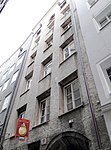
|
Bürgerhaus, Spinnstätterhaus (1775) ObjectID : 44266 |
Goldgasse 15 KG location : Salzburg |
The window frames of the six-storey town house date from the 16th century. |
ObjectID : 44266 Status : Notification Status of the BDA list: 2020-02-29 Name: Bürgerhaus, Spinnstätterhaus (1775) GstNr .: 59 |

|
Bürgerhaus, Glasererhaus ObjectID : 42710 |
Goldgasse 16 KG location : Salzburg |
The facade of the five-storey town house contains a picture of the Holy Trinity from the 18th century. |
ObjectID : 42710 Status : Notification Status of the BDA list: 2020-02-29 Name: Bürgerhaus, Glasererhaus GstNr .: 44 |

|
Bürgerhaus, corner house at Aschhof, Zinngiesserhaus ObjektID : 42711 |
Goldgasse 19 KG location : Salzburg |
The core of the five-storey corner house is late medieval. The window frames on the facade facing Residenzplatz were created at the end of the 18th century. |
ObjectID : 42711 Status : Notification Status of the BDA list: 2020-02-29 Name: Bürgerhaus, Eckhaus am Aschhof, Zinngiesserhaus GstNr .: 61 |

|
Bürgerhaus, Bergerhaus ObjectID : 35605 |
Griesgasse 1 KG location : Salzburg |
The structure of the four-storey town house dates from the 17th century. |
ObjectID : 35605 Status : Notification Status of the BDA list: 2020-02-29 Name: Bürgerhaus, Bergerhaus GstNr .: 508 |

|
Bürgerhaus, City Court Servant House ObjectID : 35606 |
Griesgasse 3 KG location : Salzburg |
The core of the five-storey town house is late medieval. |
ObjektID : 35606 Status : Notification Status of the BDA list: 2020-02-29 Name: Bürgerhaus, Stadtgerichtsdienerhaus GstNr .: 505; 506 |
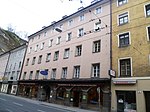
|
Bürgerhaus, formerly a princely penny parlor ObjectID : 42249 |
Griesgasse 4 KG location : Salzburg |
The core of the eight-axle structure dates from the middle of the 17th century; the red marble portal is marked 1648. |
ObjectID : 42249 Status : Notification Status of the BDA list: 2020-02-29 Name: Bürgerhaus, former princely Pfennigstube GstNr .: 436/1 |

|
Bürgerhaus ObjektID : 44270 |
Griesgasse 6 KG location : Salzburg |
The four-storey house with a concave end was built in the 1st half of the 17th century. |
ObjectID : 44270 Status : Notification Status of the BDA list: 2020-02-29 Name: Bürgerhaus GstNr .: 437 |

|
Bürgerhaus, Griesbaderhaus ObjectID : 44269 |
Griesgasse 7 KG location : Salzburg |
ObjectID : 44269 Status : Notification Status of the BDA list: 2020-02-29 Name: Bürgerhaus, Griesbaderhaus GstNr .: 497 |
|

|
Marianum ObjectID : 60828 |
Griesgasse 8 KG location : Salzburg |
The four-storey house with transversely oval attic hatches and concave fillets was built in the first half of the 17th century. The window frames with plate style decor date from the end of the 18th century. |
ObjectID : 60828 Status: § 2a Status of the BDA list: 2020-02-29 Name: Marianum GstNr .: 438; 439/1 Griesgasse 8, Salzburg |

|
Bürgerhaus, Trenkhor or Löchlbogen ObjectID : 35607 |
Griesgasse 9 KG location : Salzburg |
The former upper drinking gate of the wall from 1280 was built over by the seven-storey town house in the 16th and 17th centuries. The facade with the window frames dates from the first half of the 19th century. |
ObjectID : 35607 Status : Notification Status of the BDA list: 2020-02-29 Name: Bürgerhaus, Trenkhor or Löchlbogen GstNr .: 495 Griesgasse 9, Salzburg |

|
Bürgerhaus ObjektID : 35608 |
Griesgasse 11 KG location : Salzburg |
The town house with a two-storey bay window was built around a tower of the old city wall in the 16th and 17th centuries. Seat of the Zürcher Kantonalbank Austria . |
ObjectID : 35608 Status : Notification Status of the BDA list: 2020-02-29 Name: Bürgerhaus GstNr .: 494 Griesgasse 11, Salzburg |

|
Bürgerhaus, Kronhaus ObjectID : 42174 |
Griesgasse 15 KG location : Salzburg |
Behind the single-storey shop fronts is the town house, which essentially dates from the 15th and 16th centuries. |
ObjectID : 42174 Status : Notification Status of the BDA list: 2020-02-29 Name: Bürgerhaus, Kronhaus GstNr .: 484/1 |

|
Bürgerhaus ObjektID : 42279 |
Griesgasse 17 KG location : Salzburg |
The ten-axis, five-storey town house originally dates from the 16th century and was rebuilt in the 17th century. The window frames of the facade were created in the second half of the 19th century. |
ObjectID : 42279 Status : Notification Status of the BDA list: 2020-02-29 Name: Bürgerhaus GstNr .: 477; 478 Griesgasse 17, Salzburg |
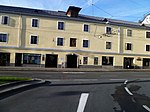
|
Bürgerhaus, Fleischbankstock ObjektID : 35609 |
Griesgasse 19,19a KG location : Salzburg |
The elongated three-story house with a simple facade was originally built as a meat bank in 1608. |
ObjectID : 35609 Status : Notification Status of the BDA list: 2020-02-29 Name: Bürgerhaus, Fleischbankstock GstNr .: 470; 474/1 |
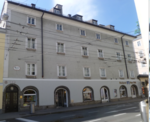
|
Town house, former blacksmith's shop at Trenkhore ObjektID : 42057 |
Griesgasse 21 KG location : Salzburg |
The core of the three-storey town house with a loft and a hollow stems from the 17th century. |
ObjectID : 42057 Status : Notification Status of the BDA list: 2020-02-29 Name: Bürgerhaus, former forge at Trenkhore GstNr .: 469 |

|
Bürgerhaus, Köglhaus ObjectID : 42058 |
Griesgasse 27 KG location : Salzburg |
The four-storey town house with an extended attic storey was built around the middle of the 17th century. |
ObjectID : 42058 Status : Notification Status of the BDA list: 2020-02-29 Name: Bürgerhaus, Köglhaus GstNr .: 450 |

|
Bürgerhaus, Fuchsenhaus ObjektID : 42248 |
Griesgasse 29 KG location : Salzburg |
The four-storey town house with a moat roof was built around the middle of the 17th century. The arched portal was probably built at the end of the 18th century. |
ObjectID : 42248 Status : Notification Status of the BDA list: 2020-02-29 Name: Bürgerhaus, Fuchsenhaus GstNr .: 449 |

|
Community house, fishwaters house or fox house ObjectID : 42409 |
Griesgasse 31 KG location : Salzburg |
The four-storey town house with an extended attic storey was built around the middle of the 17th century. |
ObjectID : 42409 Status : Notification Status of the BDA list: 2020-02-29 Name: Bürgerhaus, Fischwässerer- or Fuchsenhaus GstNr .: 448/1 |

|
Town house, former grinding mill ObjectID : 35610 |
Gstättengasse 1 KG location : Salzburg |
The four-storey town house with a simple facade and cove is built directly on the vertically sloping rock face and its core dates from the 16th and 17th centuries. |
ObjectID : 35610 Status : Notification Status of the BDA list: 2020-02-29 Name: Bürgerhaus, former grinding mill GstNr .: 389 Gstättengasse 1, Salzburg |
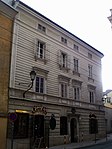
|
Bürgerhaus ObjektID : 60834 |
Gstättengasse 2 KG location : Salzburg |
The house, which is probably medieval in its core, was given its present facade in the second half of the 19th century. |
ObjectID : 60834 Status: § 2a Status of the BDA list: 2020-02-29 Name: Bürgerhaus GstNr .: 443 Gstättengasse 2, Salzburg |

|
Town house, locksmith's house ObjectID : 35611 |
Gstättengasse 3 KG location : Salzburg |
A picture of Mariahilf from the 2nd half of the 18th century is attached above the arched portal of the five-storey town house. |
ObjectID : 35611 Status : Notification Status of the BDA list: 2020-02-29 Name: Bürgerhaus, Schlosserhaus GstNr .: 390 Gstättengasse 3, Salzburg |
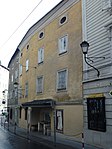
|
Residential and commercial building, oldest bakery in Salzburg Object ID: 35612 |
Gstättengasse 4 KG location : Salzburg |
The core of the probably medieval three-storey house has transversely oval attic hatches and a concave end. |
ObjectID : 35612 Status : Notification Status of the BDA list: 2020-02-29 Name: Residential and commercial building, Salzburg's oldest bakery GstNr .: 442 Gstättengasse 4, Salzburg |

|
Town house, summer hat maker house and barrel vaulted room ObjectID : 44354 |
Gstättengasse 5 KG location : Salzburg |
The five-storey town house is built directly onto the vertically sloping rock face. Its facade contains oval pictures of Saints Francis and Anthony from around 1720 with richly carved frames. |
ObjektID : 44354 Status : Notification Status of the BDA list: 2020-02-29 Name: Bürgerhaus, summer hat maker's house and barrel vaulted room GstNr .: 390; 391 |

|
Bürgerhaus ObjektID : 42255 |
Gstättengasse 6 KG location : Salzburg |
The core of the probably medieval three-storey house has transversely oval attic hatches and a concave end. |
ObjectID : 42255 Status : Notification Status of the BDA list: 2020-02-29 Name: Bürgerhaus GstNr .: 441 Gstättengasse 6, Salzburg |

|
Town house, master mason house ObjectID : 46142 |
Gstättengasse 7 KG location : Salzburg |
The core of the six-storey town house dates back to the 16th and 17th centuries. The facade decor on the upper floors was created between 1850 and 1860. |
ObjectID : 46142 Status : Notification Status of the BDA list: 2020-02-29 Name: Bürgerhaus, Maurermeisterhaus GstNr .: 392 |

|
Bürgerhaus ObjektID : 42410 |
Gstättengasse 9 KG location : Salzburg |
The facade of the five-storey town house with transversely oval attic hatches shows an oval image of Maria Immaculata. |
ObjectID : 42410 Status : Notification Status of the BDA list: 2020-02-29 Name: Bürgerhaus GstNr .: 393 |
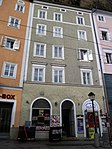
|
Bürgerhaus, Hutmacher Goberhaus ObjectID : 42411 |
Gstättengasse 11 KG location : Salzburg |
The core of the five-storey town house dates back to the 16th and 17th centuries. The window frames were created in the first half of the 19th century. |
ObjectID : 42411 Status : Notification Status of the BDA list: 2020-02-29 Name: Bürgerhaus, Hutmacher Goberhaus GstNr .: 394 |

|
Valley station Mönchsberg-Lift ObjektID : 39492 |
Gstättengasse 13 KG location : Salzburg |
ObjektID : 39492 Status : Notification Status of the BDA list: 2020-02-29 Name: Valley station Mönchsberg-Lift GstNr .: 395 Gstättengasse 13, Salzburg |
|

|
Bürgerhaus ObjektID : 42712 |
Gstättengasse 25 KG location : Salzburg |
The five-storey town house with a basket arch portal was built between 1670 and 1682. |
ObjectID : 42712 Status : Notification Status of the BDA list: 2020-02-29 Name: Bürgerhaus GstNr .: 401 |
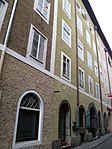
|
Bürgerhaus, so-called Second Star House ObjectID : 42291 |
Gstättengasse 27 KG location : Salzburg |
This building, along with others (23-33) , was bought up by the owner of the Sternbräus , Georg Ehrenreich Stockhamer, after the landslide on July 16, 1669 , and built up uniformly. Spacious Stockhamer beer storage cellars were located here. Wineries were located here in the 19th and 20th centuries. The facilities are used as an event location under the name Kavernen 1595 . |
ObjectID : 42291 Status : Notification Status of the BDA list: 2020-02-29 Name: Bürgerhaus, so-called Second Star House GstNr .: 402 |

|
Bürgerhaus, so-called Outer Fragnerhaus ObjektID : 42320 |
Gstättengasse 29 KG location : Salzburg |
The five-storey town house with a basket arch portal was built between 1670 and 1682. |
ObjectID : 42320 Status : Notification Status of the BDA list: 2020-02-29 Name: Bürgerhaus, so-called Outer Fragnerhaus GstNr .: 403 |

|
Town house, so-called fourth star or night king house ObjectID : 42290 |
Gstättengasse 31 KG location : Salzburg |
The five-storey town house with a basket arch portal was built between 1670 and 1682. |
ObjectID : 42290 Status : Notification Status of the BDA list: 2020-02-29 Name: Bürgerhaus, so-called Fourth Star or Night King House GstNr .: 404 |
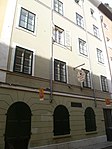
|
Bürgerhaus ObjektID : 42321 |
Gstättengasse 33 KG location : Salzburg |
The five-storey, four-axle town house was built between 1670 and 1682. |
ObjectID : 42321 Status : Notification Status of the BDA list: 2020-02-29 Name: Bürgerhaus GstNr .: 405 |

|
Bürgerhaus ObjektID : 42289 |
Gstättengasse 35 KG location : Salzburg |
The five-storey town house with rustikaportal was built between 1670 and 1682. |
ObjectID : 42289 Status : Notification Status of the BDA list: 2020-02-29 Name: Bürgerhaus GstNr .: 406 |

|
Bürgerhaus, Naglschmiedhaus ObjectID : 42288 |
Gstättengasse 37 KG location : Salzburg |
The five-storey, three-axle town house was built between 1670 and 1682. |
ObjectID : 42288 Status : Notification Status of the BDA list: 2020-02-29 Name: Bürgerhaus, Naglschmiedhaus GstNr .: 407 |

|
Villa / Country House ObjectID : 35623 |
Haydnstrasse 5 KG location : Salzburg |
The four-storey villa with corner projections and secessionist facade decor was built in 1901. |
ObjectID : 35623 Status : Notification Status of the BDA list: 2020-02-29 Name: Villa / Landhaus GstNr .: 1475 Haydnstraße 5, Salzburg |

|
Künstlerhaus ObjectID : 35622 |
Hellbrunner Strasse 3 KG location : Salzburg |
ObjectID : 35622 Status : Notification Status of the BDA list: 2020-02-29 Name: Künstlerhaus GstNr .: 2021/1 Künstlerhaus Salzburg |
|

|
Pensioners' home Hellbrunn, former KK Landwehr barracks ObjectID : 60919 |
Hellbrunner Strasse 28 KG location : Salzburg |
ObjectID : 60919 Status: § 2a Status of the BDA list: 2020-02-29 Name: Pensionistenheim Hellbrunn, formerly KK Landwehrkaserne GstNr .: 2066/1 |
|

|
Hofmarstallschwemme ObjectID : 67682 |
Herbert-von-Karajan-Platz KG location : Salzburg |
The Hofmarstallschwemme was created in connection with the facade design of the former Hofmarstall in 1695, probably based on a design by Johann Bernhard Fischer von Erlach . In front of a display wall is a basin with a group of figures of horse tamers. When it was redesigned in 1732, the display wall got its current form with horse representations in the wall panels. The group of figures was rotated 90 degrees and received a new base. |
ObjectID : 67682 Status: § 2a Status of the BDA list: 2020-02-29 Name: Hofmarstallschwemme GstNr .: 383; 3715/2 horse pond (Salzburg) |

|
Neutor / Sigmundstor with tunnel and obelisk ObjectID : 89444 |
Herbert-von-Karajan-Platz KG location : Salzburg |
ObjectID : 89444 Status: § 2a Status of the BDA list: 2020-02-29 Name: Neutor / Sigmundstor with tunnel and obelisk GstNr .: 3596; 2628; 381/1; 2611/1; 2761/1; 2538/1; 2611/2; 3597; 3715/1 Sigmundstor (Salzburg) |
|
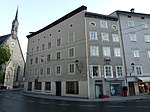
|
Bürgerhaus, rear Spitalschmiedhaus ObjectID : 40661 |
Herbert-von-Karajan-Platz 1 KG location : Salzburg |
The structure of the four-storey town house dates from the 16th and 17th centuries. |
ObjectID : 40661 Status : Notification Status of the BDA list: 2020-02-29 Name: Bürgerhaus, rear Spitalschmiedhaus GstNr .: 369 |
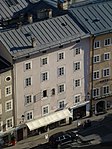
|
Bürgerhaus, Hinteres Färberhaus ObjectID : 42059 |
Herbert-von-Karajan-Platz 2 KG location : Salzburg |
The structure of the five-storey town house dates from the 16th and 17th centuries. |
ObjectID : 42059 Status : Notification Status of the BDA list: 2020-02-29 Name: Bürgerhaus, Hinteres Färberhaus GstNr .: 370 Herbert-von-Karajan-Platz 2, Salzburg |

|
Schüttkasten am Neutor, the forecourt archaeological find hope area ObjectID : 35695 |
Herbert-von-Karajan-Platz 11 KG location : Salzburg |
The three-storey farm building behind the Hofmarstallschwemme was built in the 17th century, but later redesigned. |
ObjektID : 35695 Status: § 2a Status of the BDA list: 2020-02-29 Name: Schüttkasten am Neutor, the forecourt archaeological find hope area GstNr .: 382/1; 382/2 bulk box (Salzburg) |

|
Bürgerhaus, Nikolaistöckl ObjectID : 44352 |
Herrengasse 3 KG location : Salzburg |
ObjectID : 44352 Status : Notification Status of the BDA list: 2020-02-29 Name: Bürgerhaus, Nikolaistöckl GstNr .: 242 |
|

|
Bürgerhaus ObjektID : 45393 |
Herrengasse 4 KG location : Salzburg |
ObjectID : 45393 Status : Notification Status of the BDA list: 2020-02-29 Name: Bürgerhaus GstNr .: 291 |
|

|
Gasthaus Zum Weißen Kreuz ObjectID : 44307 |
Herrengasse 8 KG location : Salzburg |
Here (also Bierjodlgasse 6) there has been a beer taps since 1687, since 1775 the restaurant was called "Bierjodlhaus", from the middle of the 19th century "Zum Weißen Kreuz", from 1949 it was subtitled "Yugoslavian restaurant" and from 1992 to 2008 then with "Balkan specialties". At the moment it is obviously empty. |
ObjectID : 44307 Status : Notification Status of the BDA list: 2020-02-29 Name: Gasthaus Zum Weißen Kreuz GstNr .: 274 |

|
Bürgerhaus, Stöcklhaus ObjectID : 44894 |
Herrengasse 10 KG location : Salzburg |
ObjectID : 44894 Status : Notification Status of the BDA list: 2020-02-29 Name: Bürgerhaus, Stöcklhaus GstNr .: 273 |
|

|
Bürgerhaus, Klocker new Widmann dwelling ObjectID : 44306 |
Herrengasse 12 KG location : Salzburg |
ObjectID : 44306 Status : Notification Status of the BDA list: 2020-02-29 Name: Bürgerhaus, Klocker new Widmannbehausung GstNr .: 272 Herrengasse 12, Salzburg |
|

|
Bürgerhaus, Leyerbrunhaus ObjectID : 44305 |
Herrengasse 14 KG location : Salzburg |
The structure of the five-storey town house dates from the 16th and 17th centuries. |
ObjectID : 44305 Status : Notification Status of the BDA list: 2020-02-29 Name: Bürgerhaus, Leyerbrunhaus GstNr .: 270 |
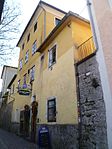
|
Bürgerhaus, Färberstöckl ObjectID : 44303 |
Herrengasse 16 KG location : Salzburg |
In this narrow house you will find the so-called "Paul-Stubn", a quaint Salzburg restaurant. This also includes a small chestnut garden, which is recommended in summer. |
ObjectID : 44303 Status : Notification Status of the BDA list: 2020-02-29 Name: Bürgerhaus, Färberstöckl GstNr .: 267; 268 |
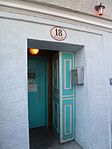
|
Bürgerhaus, Flecknerhaus ObjectID : 44304 |
Herrengasse 18 KG location : Salzburg |
The building has been home to a brothel since the 14th century, perhaps one reason for the calm approach to this establishment near the archbishop's palace. It has recently been given a historicizing guild mark. |
ObjectID : 44304 Status : Notification Status of the BDA list: 2020-02-29 Name: Bürgerhaus, Flecknerhaus GstNr .: 239 |

|
Bürgerhaus, Krinnerhaus ObjectID : 44895 |
Herrengasse 20 KG location : Salzburg |
ObjectID : 44895 Status : Notification Status of the BDA list: 2020-02-29 Name: Bürgerhaus, Krinnerhaus GstNr .: 235 |
|
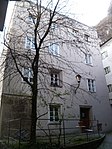
|
Bürgerhaus, Glaserer Brücknerhaus ObjectID : 44896 |
Herrengasse 22 KG location : Salzburg |
ObjectID : 44896 Status : Notification Status of the BDA list: 2020-02-29 Name: Bürgerhaus, Glaserer Brücknerhaus GstNr .: 233/1 |
|
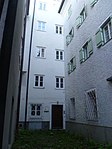
|
Bürgerhaus ObjektID : 45266 |
Herrengasse 22a KG location : Salzburg |
ObjectID : 45266 Status : Notification Status of the BDA list: 2020-02-29 Name: Bürgerhaus GstNr .: 233/2 |
|

|
Bürgerhaus ObjektID : 41721 |
Herrengasse 24 KG location : Salzburg |
ObjectID : 41721 Status : Notification Status of the BDA list: 2020-02-29 Name: Bürgerhaus GstNr .: 232 |
|

|
Bürgerhaus ObjektID : 44897 |
Herrengasse 26 KG location : Salzburg |
The structure of the five-storey town house with a late Gothic arched portal dates from the 16th and 17th centuries. |
ObjectID : 44897 Status : Notification Status of the BDA list: 2020-02-29 Name: Bürgerhaus GstNr .: 230 |

|
Town house, shepherd's house or Schallhamerhaus ObjectID : 44898 |
Herrengasse 28 KG location : Salzburg |
ObjektID : 44898 Status : Notification Status of the BDA list: 2020-02-29 Name: Bürgerhaus, Hirten- or Schallhamerhaus GstNr .: 231/1; 231/2 |
|

|
Court joiner's house ObjectID : 35624 |
Herrengasse 30 KG location : Salzburg |
The structure of the four-storey town house dates from the 16th and 17th centuries. |
ObjectID : 35624 Status: § 2a Status of the BDA list: 2020-02-29 Name: Hoftischlerhaus GstNr .: 229 |

|
Foyer and stage of the small festival hall as well as winter riding school ObjectID : 40461 |
Hofstallgasse 1 KG location : Salzburg |
ObjectID : 40461 Status: § 2a Status of the BDA list: 2020-02-29 Name: Foyer and stage of the small festival hall and winter riding school GstNr .: 378/1; 3711 House for Mozart |
|

|
Summer or rock riding school ObjectID : 103415 |
Hofstallgasse 1 KG location : Salzburg |
ObjectID : 103415 Status: § 2a Status of the BDA list: 2020-02-29 Name: Summer or Felsenreitschule GstNr .: 378/1 Felsenreitschule |
|

|
Large Festival Hall ObjectID : 103179 |
Hofstallgasse 1 KG location : Salzburg |
ObjectID : 103179 Status : Notification Status of the BDA list: 2020-02-29 Name: Großes Festspielhaus GstNr .: 378/2 Großes Festspielhaus (Salzburg) |
|

|
Rental house, part of the so-called Faberhäuser ObjektID : 48903 |
Hubert-Sattler-Gasse 3 KG location : Salzburg |
The original Faberhaus , a U-shaped historical building complex from the Wilhelminian era , was built in the second half of the 19th century after the Lodron fortifications north of Mirabellplatz were torn down . The Faberhaus is named after the Viennese brewery director and client Moritz Faber and includes the addresses Rainerstraße 2, Hubert-Sattler-Gasse 1 and 3 and Franz-Josef-Straße 2 and 4. The building was designed by Franz Schommleitner and built by Valentin Ceconi . In the meantime, buildings that are similar and also built by Ceconi are called Faber houses, especially those that form the block around Rainerstraße, Hubert-Sattler-Gasse, Faberstraße, Franz-Josef-Straße. Parts of the complex were damaged in World War II. Today there is a bank in the house at Rainerstraße 2, while the other buildings also house the Salzburg magistrate's facilities. |
ObjectID : 48903 Status : Notification Status of the BDA list: 2020-02-29 Name: Rental house, part of the so-called Faberhäuser GstNr .: 1059 |

|
Andrä School ObjectID : 60998 |
Hubert-Sattler-Gasse 4 KG location : Salzburg |
The three-storey school building with a late historical facade was built from 1891 to 1893. |
ObjectID : 60998 Status: § 2a Status of the BDA list: 2020-02-29 Name: Andrä-Schule GstNr .: 911 Campus Mirabell |

|
Residential and commercial building, Hellerhaus ObjektID : 42178 |
Hubert-Sattler-Gasse 5 KG location : Salzburg |
see Hubert-Sattler-Gasse 3 |
ObjectID : 42178 Status : Notification Status of the BDA list: 2020-02-29 Name: Residential and commercial building, Hellerhaus GstNr .: 1060 Hubert-Sattler-Gasse 5, Salzburg |

|
Residential and commercial building, Hellerhaus ObjektID : 42179 |
Hubert-Sattler-Gasse 7 KG location : Salzburg |
see Hubert-Sattler-Gasse 3 |
ObjectID : 42179 Status : Notification Status of the BDA list: 2020-02-29 Name: Residential and commercial building, Hellerhaus GstNr .: 1064/1 Hubert-Sattler-Gasse 7, Salzburg |

|
Herz Jesu- Asylkirche ObjectID : 60811 |
Hübnergasse location KG: Salzburg |
ObjectID : 60811 Status: § 2a Status of the BDA list: 2020-02-29 Name: Herz Jesu- Asylkirche GstNr .: 3041 Herz-Jesu-Asylkirche |
|
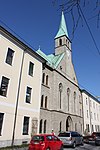
|
Retirement home, Asylum Riedenburg and figure shrine Maria Immaculata ObjektID : 80862 |
Hübnergasse 5 KG location : Salzburg |
The Herz-Jesu-Heim (formerly Herz-Jesu-Asylum) is now used as a senior citizens' home and nursing home by the Sisters of Mercy (Daughters of Christian Love) of St. Vincent operated by Paul .
The statue of Maria Immaculata originally belonged to a fountain that was built in front of Mozart's birthplace as a fish fountain by Archbishop Wolf Dietrich von Raitenau . In 1873 this fountain was removed and the statue was placed in the garden of the so-called asylum. This garden was a garden of Canon Anton Willibald Count Waldburg-Wolfegg . |
ObjectID : 80862 Status: § 2a Status of the BDA list: 2020-02-29 Name: Retirement home, asylum Riedenburg and figurative stick Maria Immaculata GstNr .: 3039; 3036/1 Herz-Jesu-Asylkirche |
literature
- Ilse Maltzan: The arcade courtyards. State Guild of the Building Industry Salzburg, Salzburg 1995, ISBN 3-9500214-6-7 .
- Gerhard Ammerer , Jutta Baumgarten: The Getreidegasse. Salzburg's most famous street, its houses, shops and people. Colorama Verlagsgesellschaft, Salzburg 2011, ISBN 978-3-902692-21-4 .
Web links
Commons : Listed objects in Salzburg - collection of images, videos and audio files
Individual evidence
- ↑ a b Salzburg - immovable and archaeological monuments under monument protection. (PDF), ( CSV ). Federal Monuments Office , as of February 17, 2020.
- ↑ See illustration of the Faberhaus from 1875 on www.stadt-salzburg.at .
- ↑ Sacred Heart Home
- ↑ § 2a Monument Protection Act in the legal information system of the Republic of Austria .